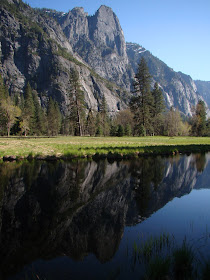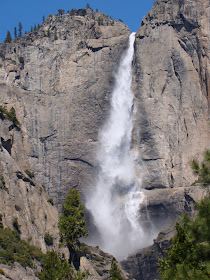What is my favorite season in Yosemite? Hard to say, but I tend to think that it is whatever season it is when I happen to be there. Except maybe for hot dusty August. I just had the happy opportunity to spend two straight weekends in the valley introducing my students to the fascinating geology to be found there.
And a few living things as well. Can anyone tell me what kind of butterfly this is?
The spring melt, very unfortunately, is coming early this year. We had a great beginning in our precipitation totals through December, but the skies suddenly dried up, and we had the driest January to March precipitation on record, with a paltry 26% of normal. The early snows are gone, and the few additional snowdrifts are melting rapidly. But there is water in the valley right now, and the falls were full and booming. It was a beautiful day.
Iconic Half Dome was nicely reflected from a pond in the Cooks Meadow area. Half Dome, or more correctly Three-Quarters Dome, stood high above the icefields that filled Yosemite during the ice ages, and achieved its shape from exfoliation and jointing.
Sentinel Dome is sometimes missed, as it lies on the opposite side of the valley from Yosemite Falls. It is a spectacular edifice that would be the focus of a national park if it existed any place besides Yosemite Valley.
We went to some of the usual places. From Tunnel View we had a perspective of Half Dome from near the spot where the valley was first discovered by Americans of European descent. It must have been a stunning sight in 1851, although the significance of the awesome valley was lost on most of the militia members, who were more intent on capturing Miwok Indians. The medic for the crew, Lafayette Bunnell, was deeply impressed and his writings were part of the inspiration for making Yosemite a national Park. The Cathedral Rocks were sharply etched into the cloudless sky, and Bridalveil Fall was full. Thousands of people see this every day. What was it like to be the first person to see it, whether in 1851, or 4,000-5,000 years ago?
In springtime, Yosemite is graced with a multitude of incredible waterfalls, some of which don't last into the summer. One example is Ribbon Fall, which at 1,612 feet is actually higher than Upper Yosemite Falls (1,430 feet). It is just west of El Capitan and is easily viewed by visitors at Bridalveil Falls across the valley. It will probably be dry in a few short weeks, which is why it is less known.
Yosemite Falls was nothing short of spectacular. With a total drop of 2,425 feet, it is the fifth or sixth highest waterfall in the world. Its roar could be heard all over the center of Yosemite Valley.
I hiked to the lower falls as well. At 320 feet, it is dwarfed by the others, but a trail ascends quite close to the base, and it both wet and exhilarating to draw close. I had chosen to walk to the upper end of the valley, realizing that I could get there almost as fast as the tramways (lots of tram stops getting from one end of the valley to the other).
The dogwoods were starting to bloom out too. It's one of the nicest signs of spring.
There aren't many other flowers on the valley floor yet, but our drive through the foothills afforded a great deal of color. There were white lupines....
And a small magenta flower I didn't recognize. Can anyone identify it?
Blue lupine could be seen all over the place...
And finally, a robin posed for me.
And that's how it was today.















you lucky, lucky bastard, to quote monty python. beautiful pics.
ReplyDeleteI think the butterfly might be a Chalcedon Checkerspot. I'm no expert but I took a picture of a similar butterfly yesterday and looked it up. It's beautiful whateve it is. http://www.butterfliesandmoths.org/species/Euphydryas-chalcedona And thanks for blogging all of this. I've spent a few hours now reading through it. I'll definitely keep it in mind when I'm planning my explorations of California.
ReplyDeleteThe butterfly is Euphydryas editha rubicunda, the Edith's checkerspot that occurs along the western foothills of the Sierra, mostly below 3000'. it's a male, but the females lay their eggs on Collinsia tinctoria, which you didn't post a photo of. I've not previously seen records of it in Yosemite Valley, but a famous site for the butterfly is at Indian Flat along the Merced River on the way into the park. the butterfly would be a real find if you took the picture in YNP...
ReplyDeleteI took the butterfly picture at Indian Flats on our way into the valley, so no coup!
ReplyDelete